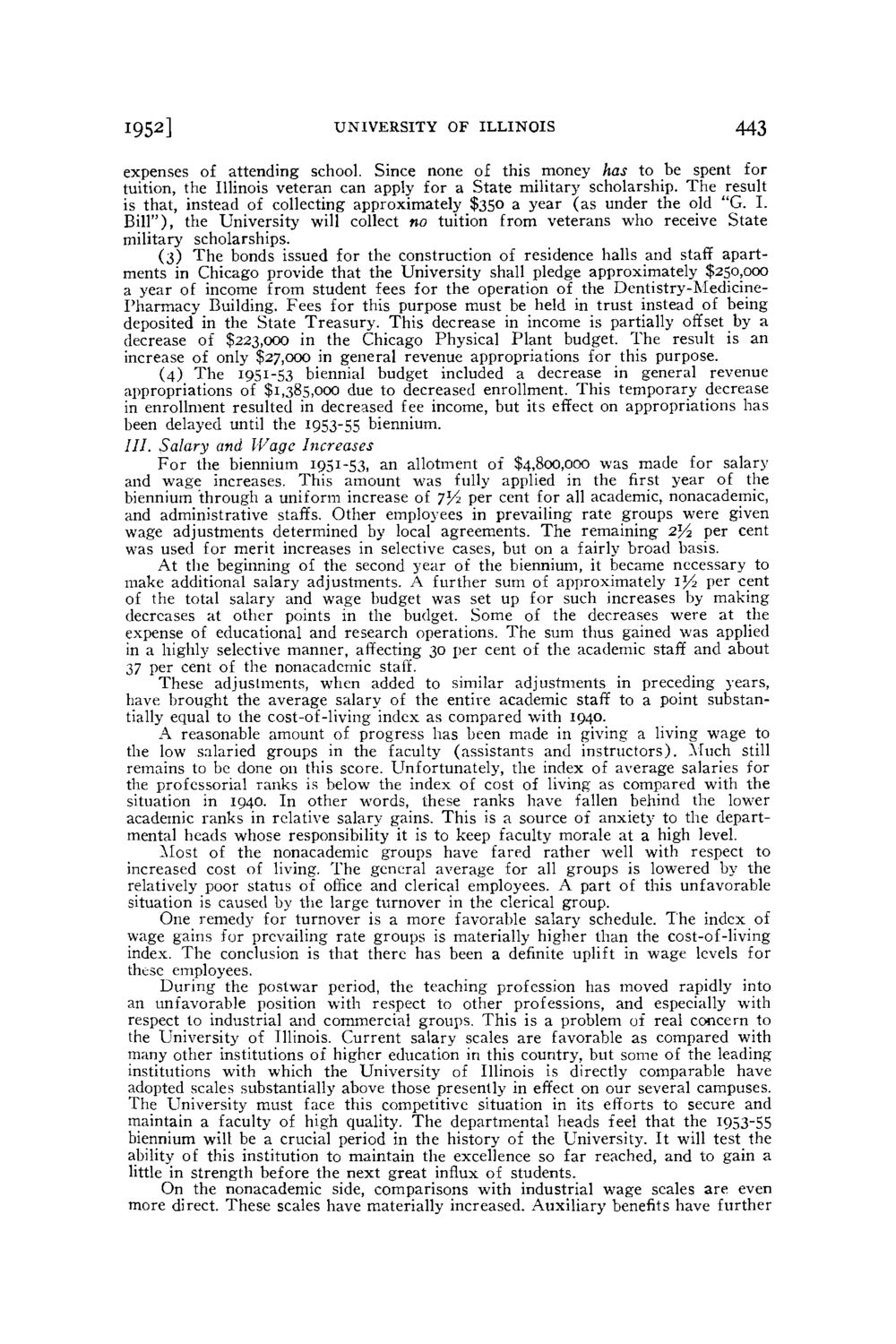| |
| |
Caption: Board of Trustees Minutes - 1954
This is a reduced-resolution page image for fast online browsing.

EXTRACTED TEXT FROM PAGE:
1952] UNIVERSITY OF ILLINOIS 443 expenses of attending school. Since none of this money has to be spent for tuition, the Illinois veteran can apply for a State military scholarship. The result is that, instead of collecting approximately $350 a year (as under the old "G. I. Bill"), the University will collect no tuition from veterans who receive State military scholarships. (3) The bonds issued for the construction of residence halls and staff apartments in Chicago provide that the University shall pledge approximately $250,000 a year of income from student fees for the operation of the Dentistry-MedicinePharmacy Building. Fees for this purpose must be held in trust instead of being deposited in the State Treasury. This decrease in income is partially offset by a decrease of $223,000 in the Chicago Physical Plant budget. The result is an increase of only $27,000 in general revenue appropriations for this purpose. (4) The 1951-53 biennial budget included a decrease in general revenue appropriations of $1,385,000 due to decreased enrollment. This temporary decrease in enrollment resulted in decreased fee income, but its effect on appropriations has been delayed until the 1953-55 biennium. / / / . Salary and Wage Increases F o r the biennium 1951-53, an allotment of $4,800,000 was made for salary and wage increases. This amount was fully applied in the first year of the biennium through a uniform increase of "jYi per cent for all academic, nonacademic, and administrative staffs. Other employees in prevailing rate groups were given wage adjustments determined by local agreements. The remaining 2l/2 per cent was used for merit increases in selective cases, but on a fairly broad basis. At the beginning of the second year of the biennium, it became necessary to make additional salary adjustments. A further sum of approximately lJ-4 per cent of the total salary and wage budget was set up for such increases by making decreases at other points in the budget. Some of the decreases were at the expense of educational and research operations. The sum thus gained was applied in a highly selective manner, affecting 30 per cent of the academic staff and about 37 per cent of the nonacademic staff. These adjustments, when added to similar adjustments in preceding years, have brought the average salary of the entire academic staff to a point substantially equal to the cost-of-living index as compared with 1940. A reasonable amount of progress has been made in giving a living wage to the low salaried groups in the faculty (assistants and instructors). Much still remains to be done on this score. Unfortunately, the index of average salaries for the professorial ranks is below the index of cost of living as compared with the situation in 1940. In other words, these ranks have fallen behind the lower academic ranks in relative salary gains. This is a source of anxiety to the departmental heads whose responsibility it is to keep faculty morale at a high level. Most of the nonacademic groups have fared rather well with respect to increased cost of living. The general average for all groups is lowered by the relatively poor status of office and clerical employees. A part of this unfavorable situation is caused by the large turnover in the clerical group. One remedy for turnover is a more favorable salary schedule. The index of wage gains for prevailing rate groups is materially higher than the cost-of-living index. The conclusion is that there has been a definite uplift in wage levels for these employees. During the postwar period, the teaching profession has moved rapidly into an unfavorable position with respect to other professions, and especially with respect to industrial and commercial groups. This is a problem of real concern to the University of Illinois. Current salary scales are favorable as compared with many other institutions of higher education in this country, but some of the leading institutions with which the University of Illinois is directly comparable have adopted scales substantially above those presently in effect on our several campuses. The University must face this competitive situation in its efforts to secure and maintain a faculty of high quality. The departmental heads feel that the 1953-55 biennium will be a crucial period in the history of the University. It will test the ability of this institution to maintain the excellence so far reached, and to gain a little in strength before the next great influx of students. On the nonacademic side, comparisons with industrial wage scales are even more direct. These scales have materially increased. Auxiliary benefits have further
| |